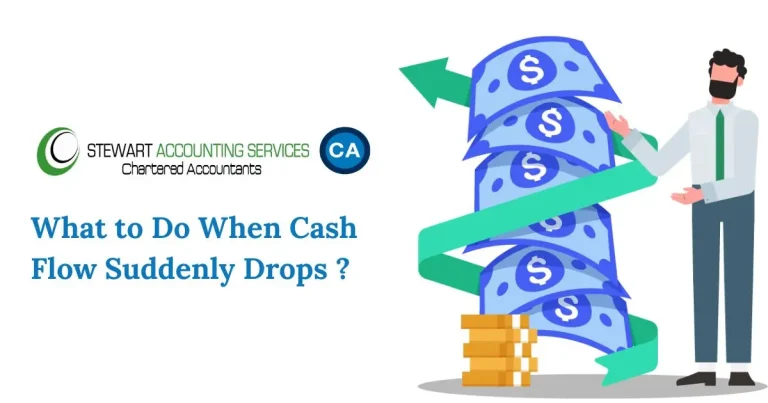Cash flow is critical for any business. Whether you operate a small family business, are in the growth stage of your start-up, or run a well-established business, cash flow is how the business continues to operate—paying staff, paying suppliers, funding future growth, and so on.
But what happens when the cash flow suddenly slows down or stops? A cash flow issue can cause immediate concern, but it does not have to spread ruin. With the appropriate steps, you can stabilize and insulate the business from anything more damaging.
This article on dealing with the undercurrent of cash flow uncertainty is from the perspective of an experienced professional accountant. Here are seven steps to take to effectively and calmly manage a decrease in your cash flow situation.
Don’t Panic—Assess the Situation Calmly
The first thing to do is take a deep breath and do your best to abstain from any immediate knee-jerk reactions. Cash flow issues happen for many reasons: delayed payment of accounts receivable, seasonality, cost increases, and unexpected expenses, just to name a few.
Start by analysing your cash flow statement. Identify:
- How severe the drop is
- Which areas are most affected (sales, collections, expenses)
- Whether it’s a short-term fluctuation or a potential ongoing issue
Once you understand the root cause, you can take targeted action instead of guessing.
Prioritise Essential Payments
When cash gets short, it is important that you prioritize your outgoing costs. Divide your spending into two portions:
- Essential: for example, payroll, rent, utilities, and essential supplier payments
- Non-essential: discretionary spending, additional marketing, or postponed purchases
Be sure to pay what is essential to keep your business open and ask suppliers for an extension on anything else, or put the brakes on spending until your cash flow improves.
Optimize Your Invoicing and Collection Process
Late payments are one of the most common reasons a business in the UK runs into cash flow difficulties. Are you invoicing as efficiently as you can? Consider the following:
- Invoicing promptly as soon as work is finished,
- Clearly defined payment terms (ideally 14 and 30 days),
- Gentle reminders before the due date,
- Early payment discounts if possible.
Longstanding clients are likely to have outstanding payments; consider gentle but firm follow-up or a follow-up with a payment plan.
Be honest with your lenders and suppliers.
If you think you are going to struggle to meet some or all of these obligations, it is more beneficial to have an open and honest conversation about your situation as soon as possible. Pick up the phone and contact lenders, landlords, or suppliers and be upfront with them as to your situation.
Most will want to work with you if they see you are being honest and responsible. You may have options for deferred payments, a temporary extension, or timely credit arrangements, which will alleviate your short-term pressures.
Review Your Pricing and Cost Structure
When you experience a cash decline, this is a good time to think about your pricing strategy and cost structure. Is your pricing in line with the current market? Are you underpricing your services?
When it comes to your costs, it’s always worth looking at your expenses (no savings is too small). Think about renegotiating supplier agreements, moving to cheaper service providers, or discontinuing your least profitable products.
Financing Options—Borrow but Be Smart
If you are in need of immediate cash inflow, you could consider more short-term financing options such as:
- A business overdraft
- Invoice factoring or discounting
- A short-term business loan.
Just be careful: the point of borrowing is to be a bridge and not a crutch. You must have a repayment strategy and consider the cost of borrowing.
Start Monitoring and Forecasting Cash Flow Regularly
Once the immediate situation is rectified, you will want to put systems in place so that you are not placed in that situation again. A reliable cash flow forecast can help you see a downturn in revenue and plan.
If you have cloud-accessed accounting software or still work with your accountant, consider developing some kind of forecasting based on:
- Potential income and outgoings for a 3-6 month period
- Income and outgoings based on seasonal trends or based on expected expenses
- Best- and worst-case scenarios.
This proactive approach allows you to take action much sooner than being reactionary.
Seek Professional Advice Early
Sometimes, even the most experienced business owners need a second pair of eyes. If cash flow problems persist, speak to your accountant or financial adviser as soon as possible.
An accountant can help identify hidden inefficiencies, restructure debt, or create a tailored recovery plan. In some cases, early professional intervention can prevent more serious financial distress.
A sudden drop in cash flow can be worrisome, but it does not have to destroy your business. The important thing is clarity, communication, and control.
By getting clarity on what is causing the issue, prioritizing your expenditure, and taking proactive action, you can get cash flow volatility stabilized, and you can come through the other side in an even better position than before.

